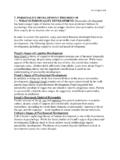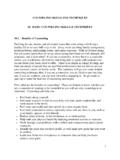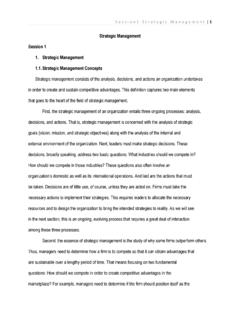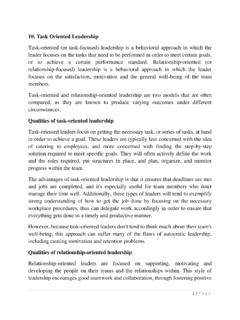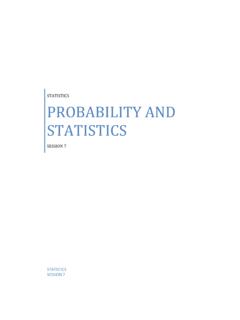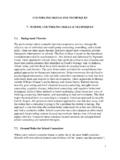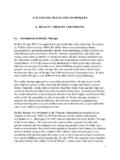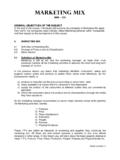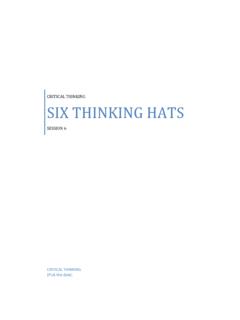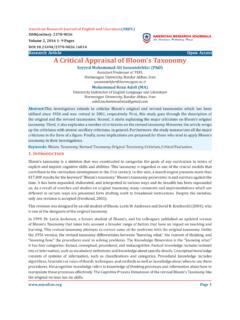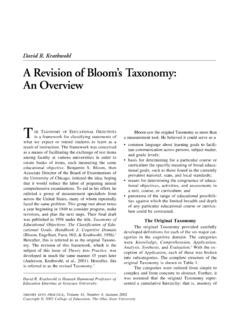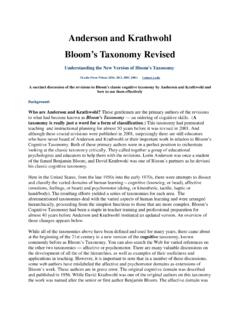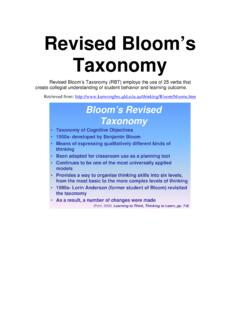Transcription of THEORIES OF LEARNING 10. BLOOM’S TAXONOMY & …
1 1 THEORIES OF LEARNING 10. bloom S TAXONOMY & DISTRIBUTED COGNITION What is bloom s TAXONOMY ? Understanding that " TAXONOMY " and "classification" are synonymous helps dispel uneasiness with the term. bloom 's TAXONOMY is a multi-tiered model of classifying thinking according to six cognitive levels of complexity. Throughout the years, the levels have often been depicted as a stairway, leading many teachers to encourage their students to climb to a higher (level of) thought. The lowest three levels are: knowledge, comprehension, and application. The highest three levels are: analysis, synthesis, and evaluation. The TAXONOMY is hierarchical where each level is subsumed by the higher levels. In other words, a student functioning at the 'application' level has also mastered the material at the 'knowledge' and 'comprehension' levels. One can easily see how this arrangement led to natural divisions of lower and higher level thinking.
2 Clearly, bloom 's TAXONOMY has stood the test of time. Due to its long history and popularity, it has been condensed, expanded, and reinterpreted in a variety of ways. Research findings have led to the discovery of a veritable smorgasbord of interpretations and applications falling on a continuum ranging from tight overviews to expanded explanations. Nonetheless, one recent revision (designed by one of the co-editors of the original TAXONOMY along with a former bloom student) merits particular attention. Changes in terminology between the two versions are perhaps the most obvious differences and can also cause the most confusion. Basically, bloom 's six major categories were changed from noun to verb forms. Additionally, the lowest level of the original, knowledge was renamed and became remembering. Finally, comprehension and synthesis were retitled to understanding and creating. In an effort to minimize the confusion, comparison images appear below.
3 2 The new terms are defined as: Remembering: Retrieving, recognizing, and recalling relevant knowledge from long-term memory. Understanding: Constructing meaning from oral, written, and graphic messages through interpreting, exemplifying, classifying, summarizing, inferring, comparing, and explaining. Applying: Carrying out or using a procedure through executing, or implementing. Analyzing: Breaking material into constituent parts, determining how the parts relate to one another and to an overall structure or purpose through differentiating, organizing, and attributing. Evaluating: Making judgments based on criteria and standards through checking and critiquing. Creating: Putting elements together to form a coherent or functional whole; reorganizing elements into a new pattern or structure through generating, planning, or producing. Structural Changes & Changes in Emphasis Structural changes seem dramatic at first, yet are quite logical when closely examined.
4 bloom 's original cognitive TAXONOMY was a one-dimensional form. With the addition of products, the revised bloom 's TAXONOMY takes the form of a two-dimensional table. One of the dimensions identifies The Knowledge Dimension (or the kind of knowledge to be learned) while the second identifies The Cognitive Process Dimension (or the process used to learn). The Knowledge Dimension on the left side is composed of four levels that are defined as Factual, Conceptual, Procedural, and Meta-Cognitive. The Cognitive Process Dimension across the top of the grid consists of six levels that are defined as Remember, Understand, Apply, Analyze, Evaluate, and Create. Each level of both dimensions of the table is subdivided. Each of the four Knowledge Dimension levels is subdivided into either three or four categories ( Factual is divided into Factual, Knowledge of Terminology, and Knowledge of Specific Details and Elements). The Cognitive Process Dimension levels are also subdivided with the number of sectors in each level ranging from a low of three to a high of eight categories.
5 For example, Remember is subdivided into the three categories of Remember, Recognizing, and Recalling while the Understanding level is divided into eight separate categories. The resulting grid, containing 19 3 subcategories is most helpful to teachers in both writing objectives and aligning standards with curricular. It is noted that bloom himself recognized that the TAXONOMY was being unexpectedly used by countless groups never considered an audience for the original publication. The revised version of the TAXONOMY is intended for a much broader audience. Emphasis is placed upon its use as a more authentic tool for curriculum planning, instructional delivery and assessment. Why use bloom 's TAXONOMY ? As history has shown, this well known, widely applied scheme filled a void and provided educators with one of the first systematic classifications of the processes of thinking and LEARNING . The cumulative hierarchical framework consisting of six categories each requiring achievement of the prior skill or ability before the next, more complex, one, remains easy to understand.
6 Out of necessity, teachers must measure their students' ability. Accurately doing so requires a classification of levels of intellectual behavior important in LEARNING . bloom 's TAXONOMY provided the measurement tool for thinking. With the dramatic changes in society over the last five decades, the revised bloom 's TAXONOMY provides an even more powerful tool to fit today's teachers' needs. The structure of the revised TAXONOMY Table matrix provides a clear, concise visual representation of the alignment between standards and educational goals, objectives, products, and activities. Today's teachers must make tough decisions about how to spend their classroom time. Clear alignment of educational objectives with local, state, and national standards is a necessity. Like pieces of a huge puzzle, everything must fit properly. The revised bloom 's TAXONOMY Table clarifies the fit of each lesson plan's purpose, "essential question," goal or objective.
7 The twenty-four-cell grid from Oregon State University that is shown above can easily be used in conjunction with Printable TAXONOMY Table Examples to clearly define the Essential Question or lesson objective. A search of the World Wide Web will yield clear evidence that bloom 's TAXONOMY has been applied to a variety of situations. Current results include a broad spectrum of applications represented by articles and websites describing everything from corrosion training to medical preparation. In almost all circumstances when an instructor desires to move a group of students through a LEARNING process utilizing an organized framework, bloom 's TAXONOMY can prove helpful. Yet the educational setting remains the most often used application. In 2002, the educational journal Theory into Practice published an entire issue on the revised bloom 's TAXONOMY . The writer describes the use of the revised 4 bloom 's TAXONOMY to plan and deliver an integrated English and history course entitled "Western Culture.
8 " The TAXONOMY provided the team-teachers with a common language with which to translate and discuss state standards from two different subject areas. Moreover, it helped them to understand how their subjects overlapped and how they could develop conceptual and procedural knowledge concurrently. Furthermore, the TAXONOMY table in the revised TAXONOMY provided the history and English teachers with a new outlook on assessment and enabled them to create assignments and projects that required students to operate at more complex levels of thinking. Additionally, The Encyclopedia of Educational Technology website contains an excellent and extensive description of the use of the revised TAXONOMY Table in writing, examining and revising objectives to insure the alignment of the objectives with both the standards and the assessments. Three charts can be found on the site one of which compares "Unclear Objectives" with " revised Objectives".
9 bloom 's group initially met hoping to reduce the duplication of effort by faculty at various universities. In the beginning, the scope of their purpose was limited to facilitating the exchange of test items measuring the same educational objectives. Intending the TAXONOMY as a method of classifying educational objectives, educational experiences, LEARNING processes, and evaluation questions and numerous examples of test items (mostly multiple choice) were included. This led to a natural linkage of specific verbs and products with each level of the TAXONOMY . Thus, when designing effective lesson plans, teachers often look to bloom 's TAXONOMY for guidance. Likewise the revised TAXONOMY includes specific verb and product linkage with each of the levels of the Cognitive Process Dimension. However, due to its 19 subcategories and two-dimensional organization, there is more clarity and less confusion about the fit of a specific verb or product to a given level.
10 Thus the revised TAXONOMY offers teachers an even more powerful tool to help design their lesson plans. Distributed Cognition Distributed cognition is a psychological theory that knowledge lies not only within the individual, but also in the individual's social and physical environment. This theory was developed in the mid-1980s by Edwin Hutchins. Using insights from sociology, cognitive science, and the psychology of Vygotsky (cultural-historical psychology) it emphasizes the social aspects of cognition. It is a framework (not a 5 method) that involves the coordination between individuals, artifacts and the environment. It has several key components: 1. Embodiment of information that is embedded in representations of interaction 2. Coordination of enaction among embodied agents 3. Ecological contributions to a cognitive ecosystem In a sense, it expresses cognition as the process of information that occurs from interaction with symbols in the world.
